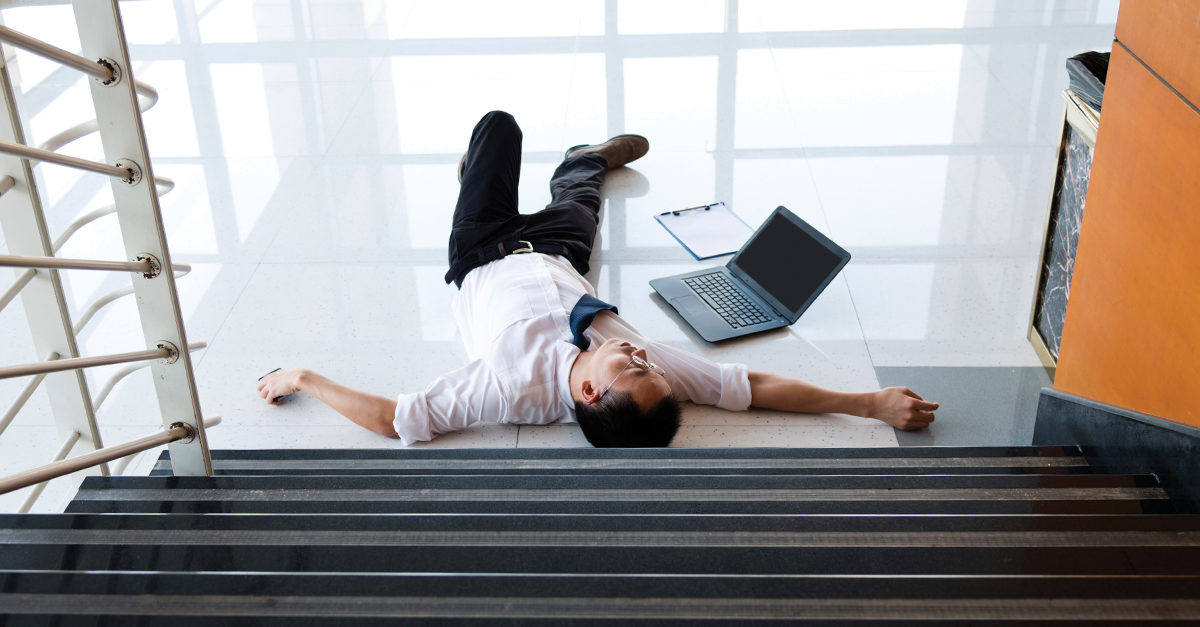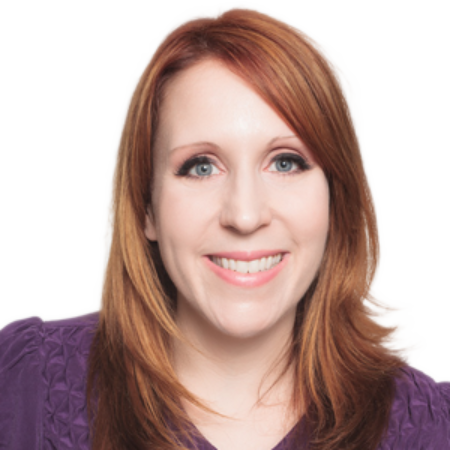Every industry faces some level of risk. With jobs that can involve using acidic cleaning agents, exposure to dangerous pathogens, and scrubbing windows while suspended from a high-rise building, commercial cleaning is no exception.
Whether an operation is based within the facility it maintains or is an outside contracting company that cleans dozens of client office buildings, commercial cleaning providers—like most other service providers—need to proactively protect themselves.
By taking steps to mitigate some of the most common—yet potentially problematic—risk scenarios, your organization may be able to prevent significant fines, lawsuits, and other penalties.
Slip-and-Fall Accidents
Same-level falls annually cost businesses more than US$10 billion, according to the 2016 Liberty Mutual Research Workplace Safety Index.
Water and other spilled materials can be a key culprit. A 2011 restaurant safety study from the Liberty Mutual Research Institute for Safety found a contaminated floor made it 14.6 times more likely someone would slip.
Prevention tip: Procedural training can help reduce the chances that cleaning professionals and building occupants will stumble. When transporting a bucket full of water, for example, place the mop in the bottom, not the wringer, which Gary Clipperton—founder and president of cleaning industry consultant and training company National Pro Clean Corp.—says can help prevent splashing when passing over doorway thresholds.
Other Accidents and Injuries
The commercial cleaning industry is no stranger to injuries, according to HM Risk Group President Ashley Hunter, who has underwritten commercial cleaning providers and other businesses for liability coverage. “Employees are moving a lot of things; you have a lot of issues with disc problems,” Hunter says. “Because of the work they’re doing, there are a lot of carpel tunnel issues.”
Injuries like these can have a damaging effect on operations.
“On the manpower side, that’s a liability for the owners of the company,” Hunter says. “When you have employees who are down, that means you have [to] hire other people; there’s a cost involved, and your workman’s compensation [coverage] can skyrocket immediately.”
Prevention tips: To avoid muscle strains, Clipperton suggests showing employees the proper way to handle heavy lifting. For example, lift upright vacuums from the middle, and consider mounting a handle on the front of a floor machine if it requires frequent transport up steps or into a van.
In-house facility managers may be willing to offer regular training sessions to ensure employees know how to avoid injury. External cleaning company owners, however, sometimes resist because it’ll take time away from cleaning work and revenue, according to D.J. Carroll, who owns commercial exterior cleaning company EasyPro Property Services in Louisville, KY.
“Without proper training, you’re begging for problems,” Carroll says. “It will actually cost you more in the long term than what you’ll pay up front for training.”
To protect yourself against erroneous claims—someone, for example, faking a fall, or tripping over his/her umbrella and insisting it was due to a wet floor—Charles Caulkins, a partner with law firm Fisher & Phillips LLP, who has represented a Florida-based commercial cleaning company for 25 years, recommends surveillance camera use.
Clearly, placing cameras in restrooms is out of the question; cameras in other spaces, though, can provide legal protection, particularly for commercial cleaning companies, which Caulkins says often accept responsibility in client contracts for fall-related accidents.
“Hopefully the owner has cameras,” he says. “If not, try to get them [installed] in critical areas with a lot of foot traffic.”
Safety and Harassment
Providing a secure environment can be a concern, particularly for cleaning professionals who work alone at night.
Training staff how to be aware of their surroundings and respond to emergency situations can help mitigate risk, Caulkins says. However, employers also need to ensure they present an atmosphere where cleaning professionals will not be sexually harassed—or accused of harassing others.
Prevention tips: Establish a policy to handle complaints, and maintain a record of staff training sessions on the topic, which can be crucial if an issue arises, according to Caulkins.
For example, Caulkins says, if one of your employees allegedly assaults someone in the building while working late at night, and that employee has a criminal record for that type of behavior, you could be considered liable for negligent hiring. To ensure you aren’t putting your employees—or other people in the building—at risk, he advises conducting employee background checks during the hiring process, if state laws pose no restrictions.
Working With Powerful Chemicals
Commercial cleaning professionals sometimes come into contact with strong substances.
Respiratory protection was one of the 10 most frequently cited U. S. Occupational Safety and Health Administration (OSHA) standards that companies violated in 2015. In addition, although the U.S. Centers for Disease Control and Prevention (CDC) notes efforts to control workplace exposure to hazardous agents have traditionally focused on inhalation, skin exposure is actually one of the most common occupational illnesses, with contact dermatitis costing more than $1 billion per year.
Prevention tips: Cleaning professionals can be taught a few tricks to reduce their exposure. For example, setting a sprayer nozzle to a semi-stream option instead of a mist distribution can help to reduce cleaning agent atomization and inhalation. Another trick involves trying to exhaust blowers and vacuums outside when using coffee stain remover, volatile spotters, or red dye or ink remover during hot water extraction.
Of course, any organization using materials that could pose an employee health risk needs to be familiar with federal health and safety regulations; some states also have specific health and safety guidelines, according to Caulkins. He suggests hiring a safety manager, if possible, to ensure you are compliant.
A smaller company may find hiring a consultant more economical. The cost of bringing in a hazardous materials specialist to provide instruction may be “in the thousands,” according to Michael Bogin, principal at New York law firm Sive, Paget & Riesel P.C.—which he says is well worth it. “Having employees appropriately trained on how to handle different types of materials, and what amounts to use, is probably the most important way of reducing potential liability,” Bogin says.
Employees should also be informed that improper disposal could trigger U.S. Environmental Protection Agency (EPA) or state regulatory agency penalties. “Make sure people washing floors know not to just dump all soapy, oily liquids down a storm drain or toss a bucket of what you’re using to clean up oil out a back door,” Bogin says. “If there happens to be someone watching, that’s a violation of the Clean Water Act.”
Penalties, according to Bogin, can be as much as $40,000 per violation—plus the additional cost to clean up the area.
Cybersecurity
Data breaches cost U.S. organizations an average of $217 per compromised record last year, according to a report from IBM and the Ponemon Institute.
“Commercial cleaning companies often feel they don’t have exposure—but you have a web presence; you’re talking to people online and are probably taking payments by credit card or purchase order,” says Hunter from HM Risk Group. “They are responsible for the information and don’t realize it.”
Prevention tips: Cleaning providers can purchase an insurance policy that provides coverage in the event of a breach, such as exposure of client records.
“The federal government has requirements about how much time you have until you have to notify everyone, and how much you spend to do that; you have to offer credit monitoring to everyone exposed for [a] year—it’s a federal mandate, and the costs are endless,” Hunter says.
Prepping for the Unexpected
Lawsuits, operational issues, and regulatory fines can cause significant damage to an in-house cleaning operation’s budget or a cleaning company’s bottom line. However, rigorous, regular training—coupled with comprehensive insurance coverage—can provide protection.
If you are looking for methods to help mitigate risk, Carroll from EasyPro Property Services suggests talking to your insurance broker as part of your research.
“Make sure he is clear about how you operate and the level of risk you are willing to tolerate,” Caulkins says. “Don’t just go for the cheapest policy. Go for the one that gives you enough protection so you can sleep well at night.”
The amount of overall insurance you will need depends on your organization size and revenue, according to Hunter; a one- or two-person cleaning crew might need $5,000 or $6,000 worth annually; larger outfits, she says, could spend upwards of $100,000.
Whether or not you decide to purchase additional insurance, sitting down to talk about your needs with an agent can ensure you meet your insurer’s requirements—such as putting certain safety measures in place—which will prove helpful, if you ever need to file a claim.
“There are conditions on every last policy,” Hunter says. “We want companies to make sure they’re maintaining that level of professionalism and doing what they’re supposed to do. We don’t want you to put anyone knowingly at risk.”



